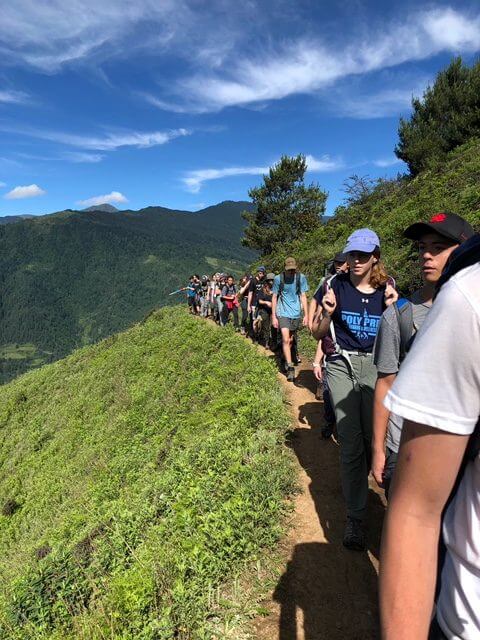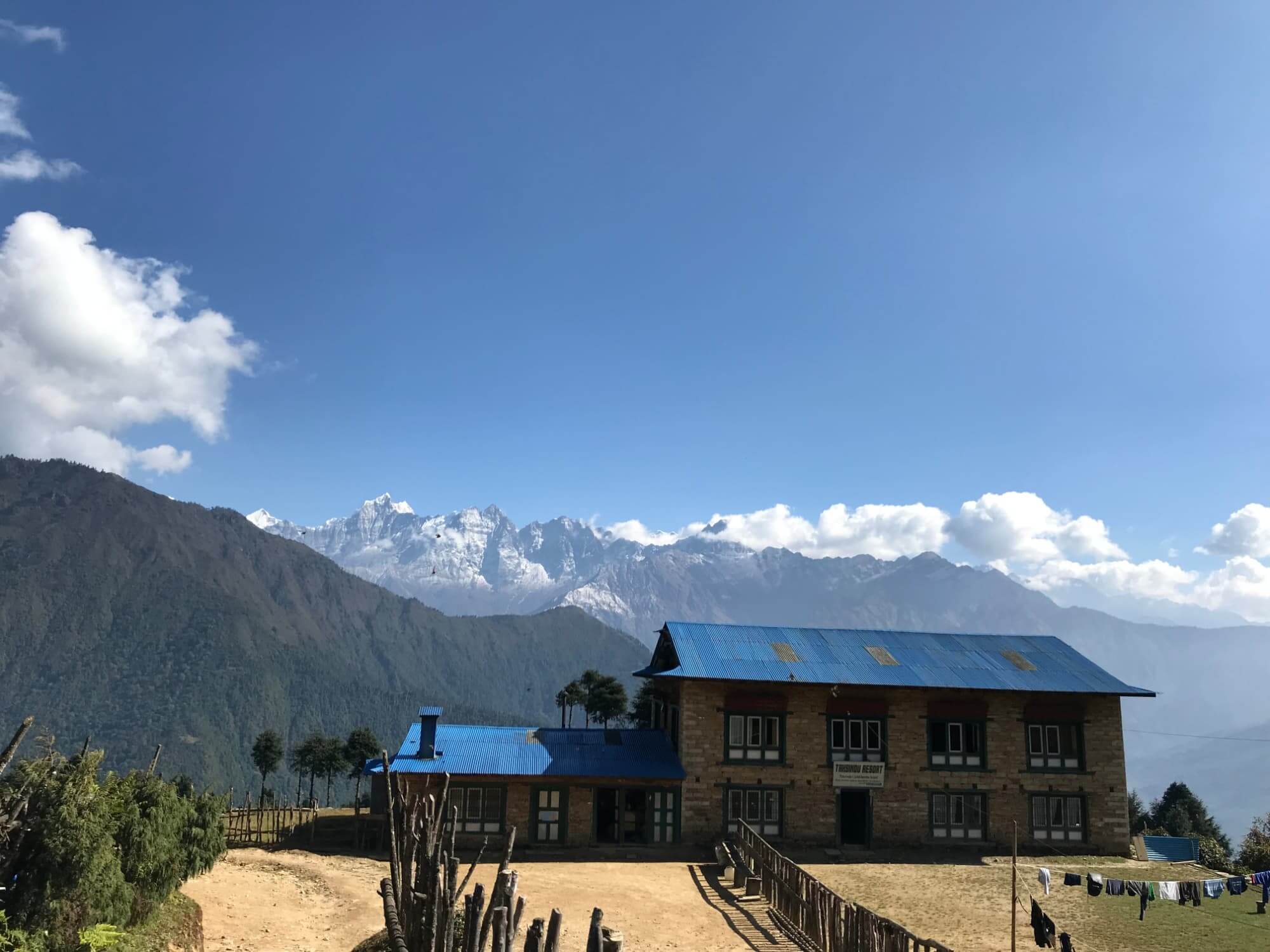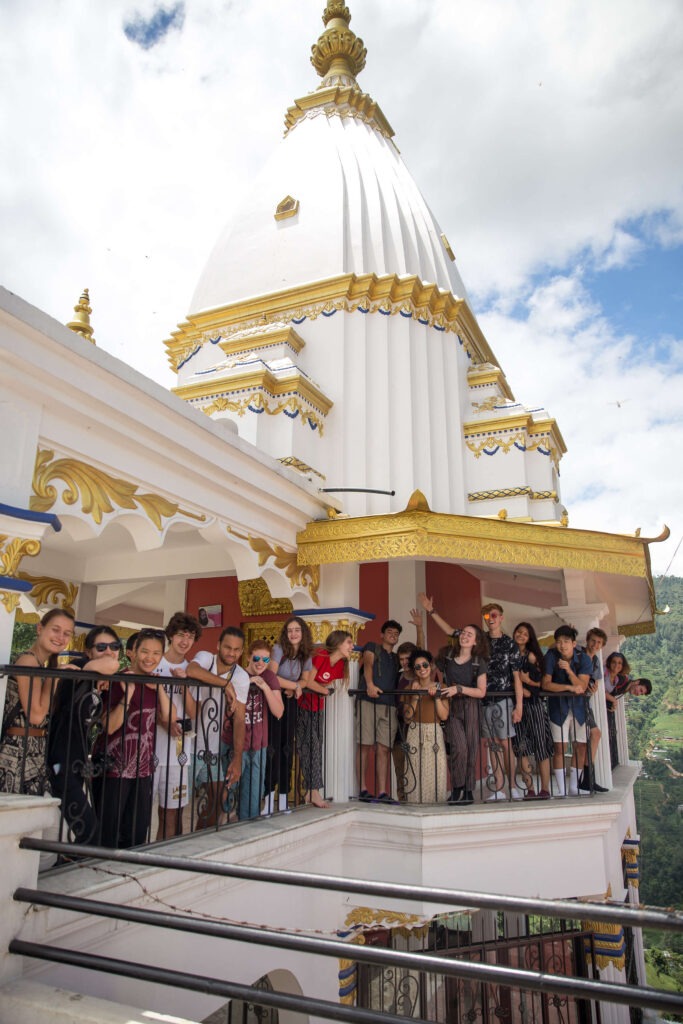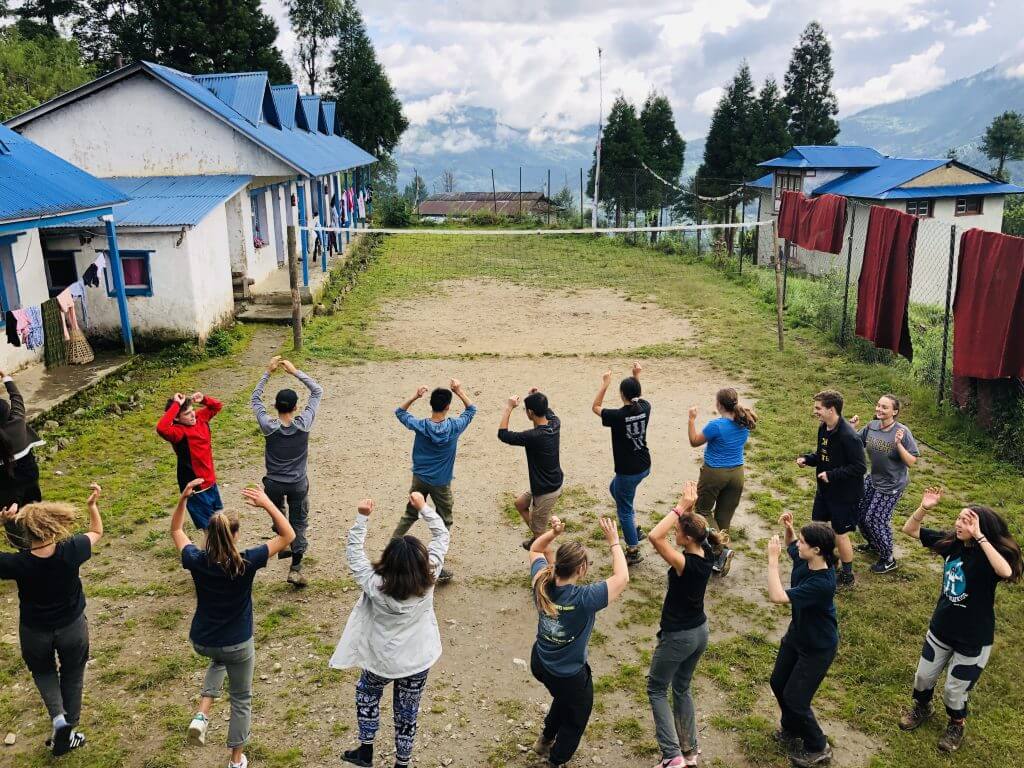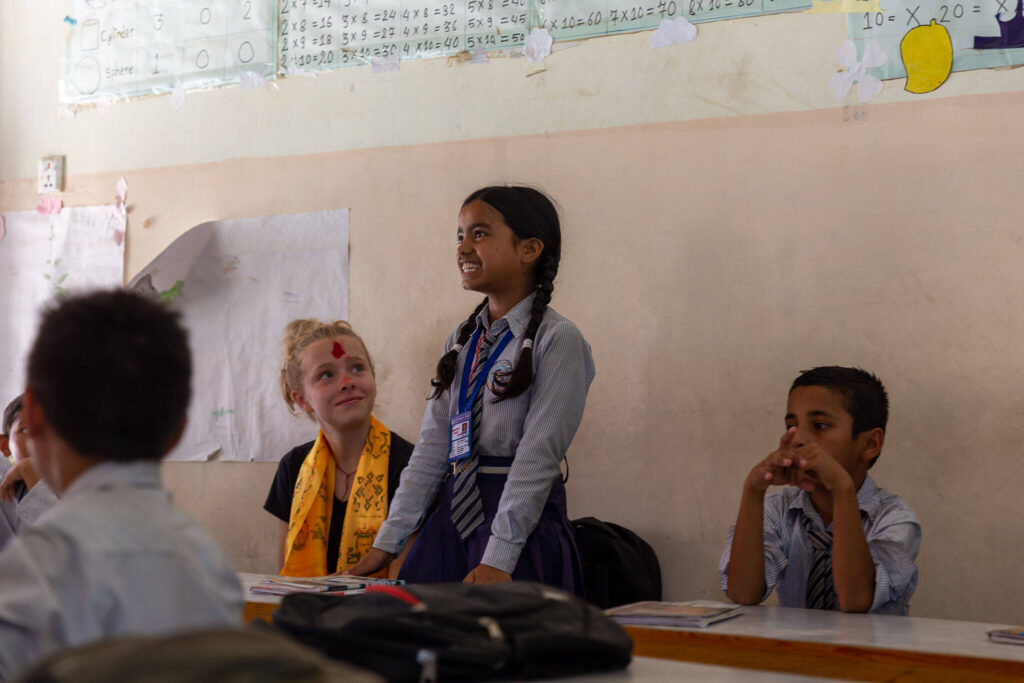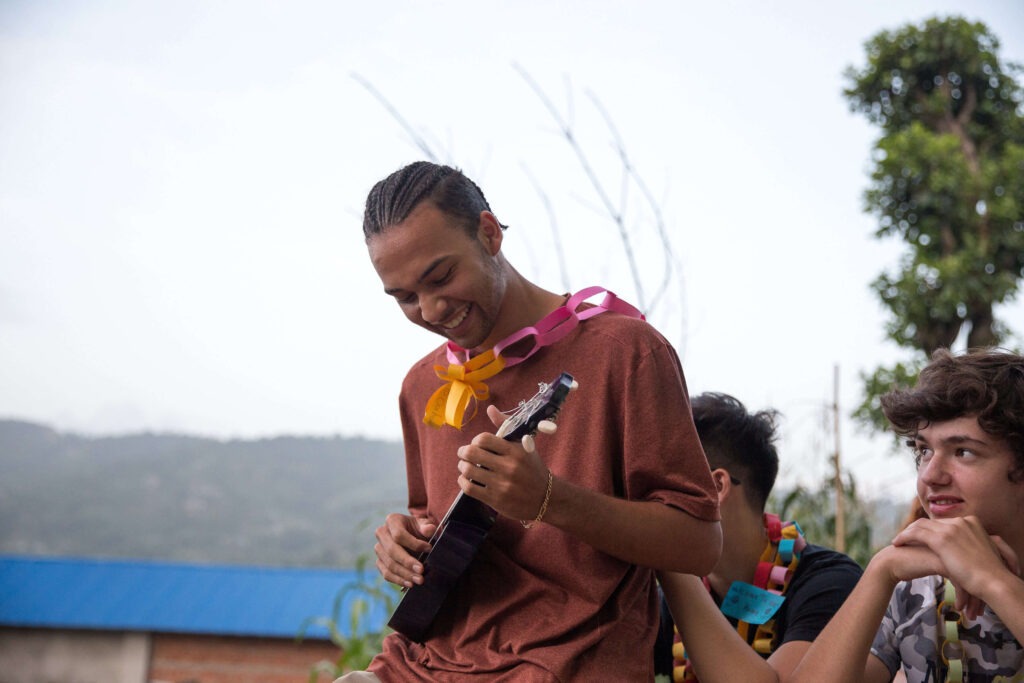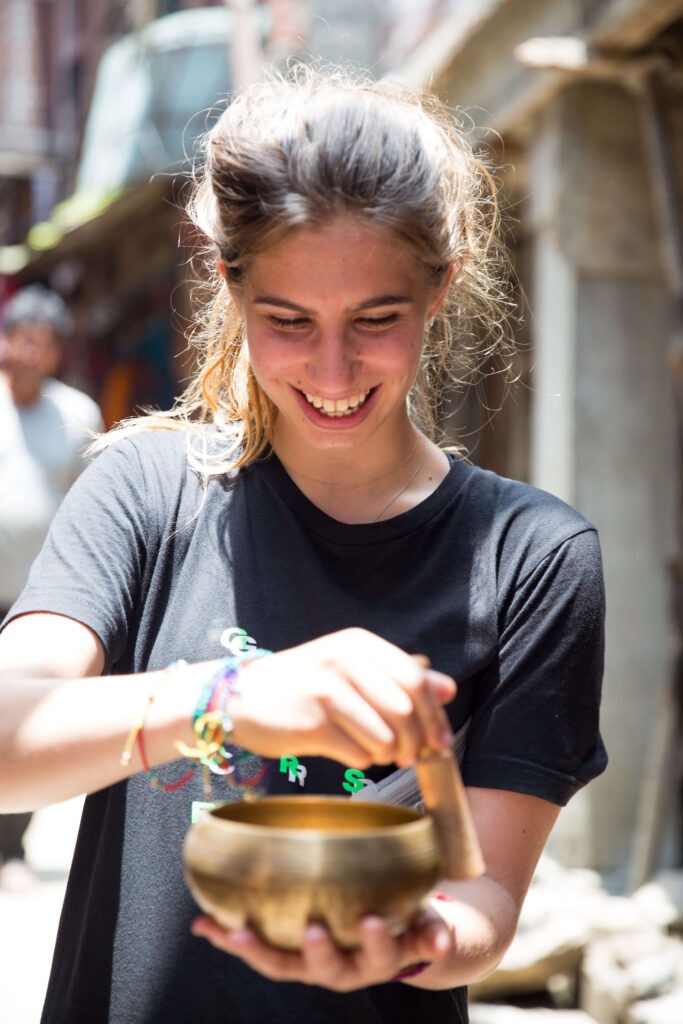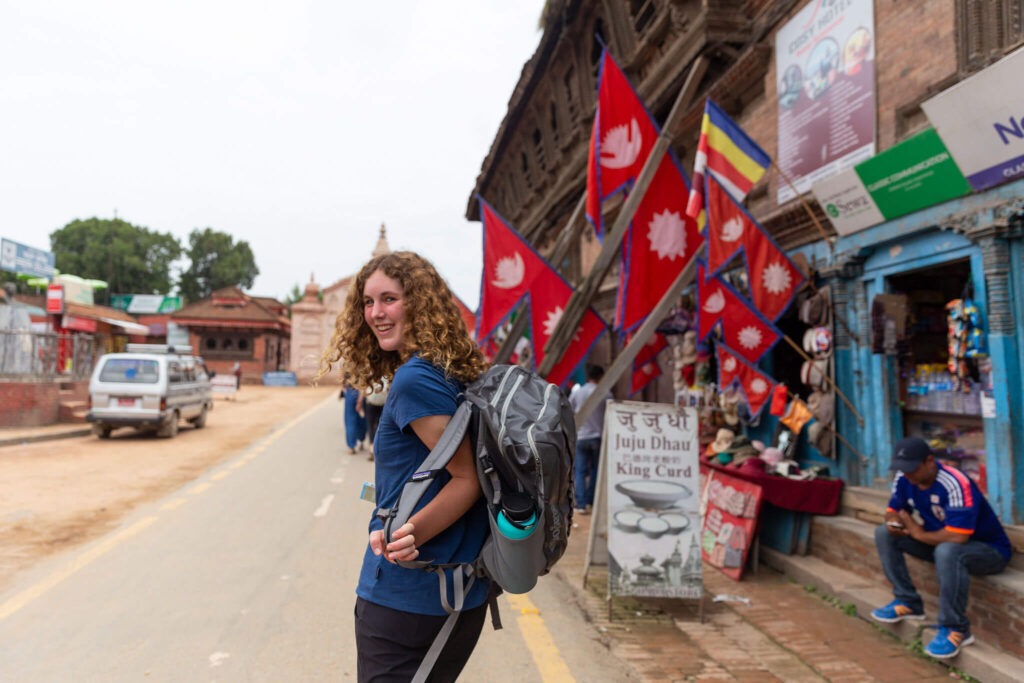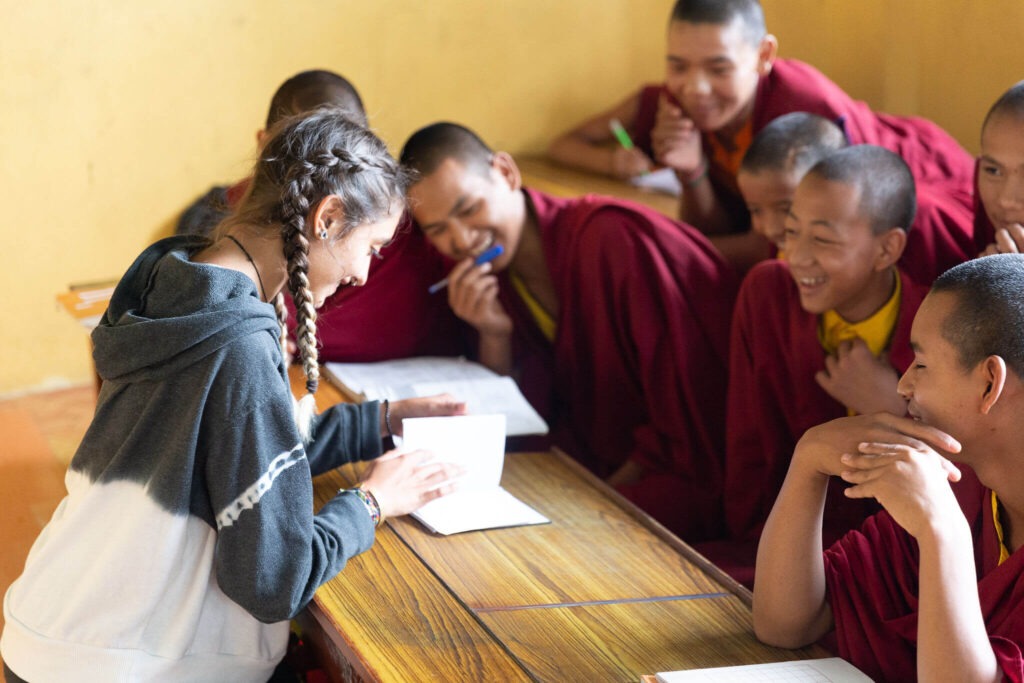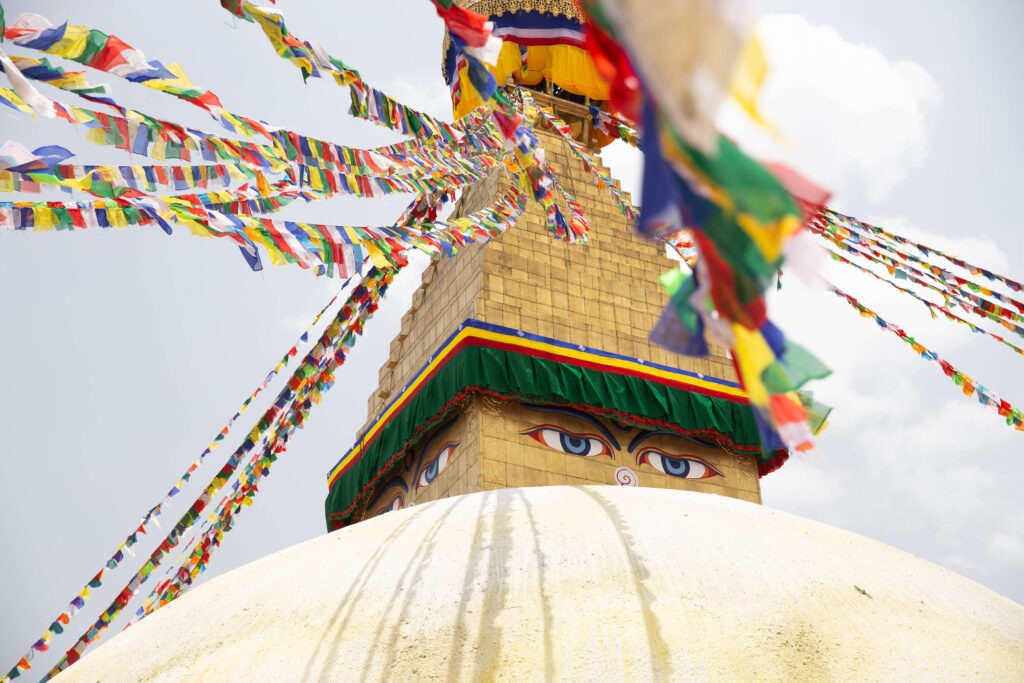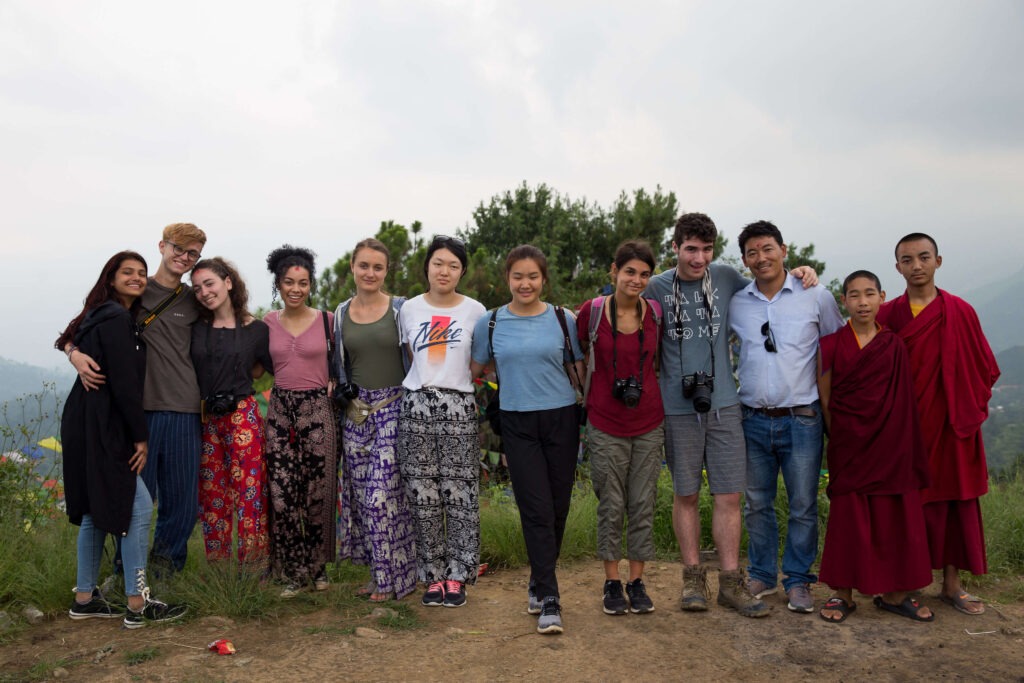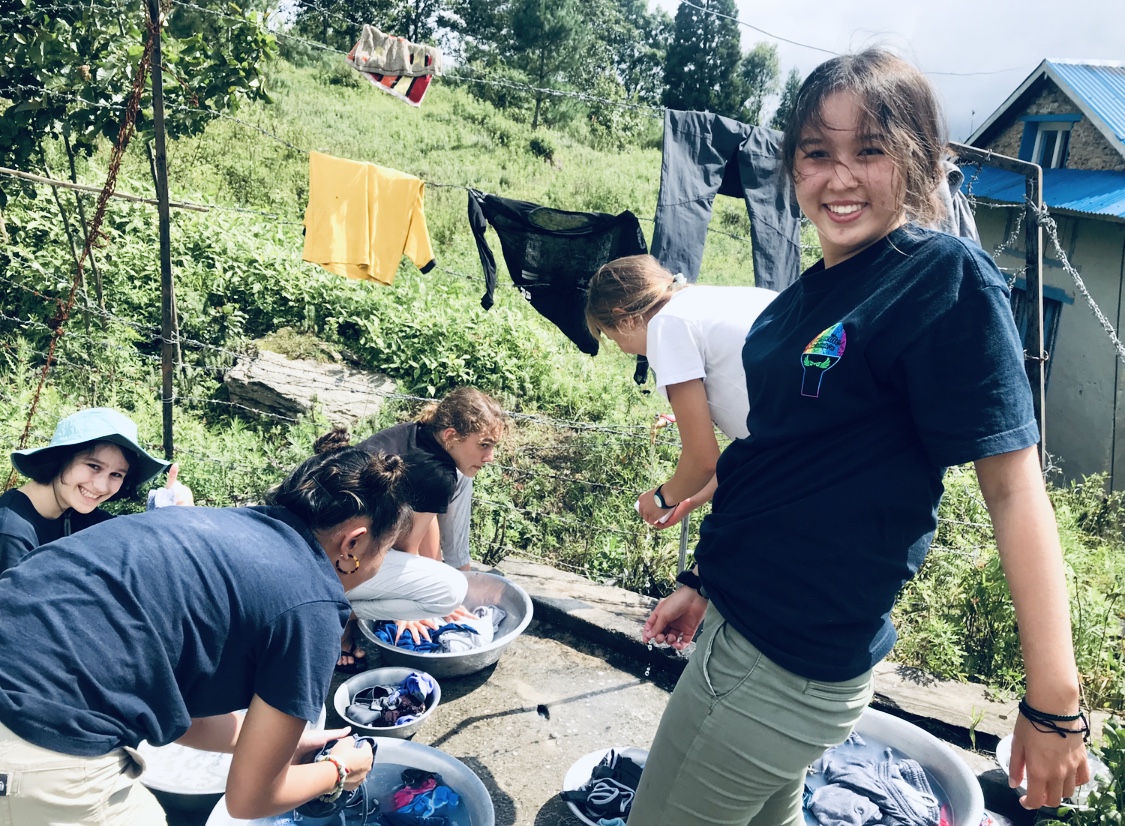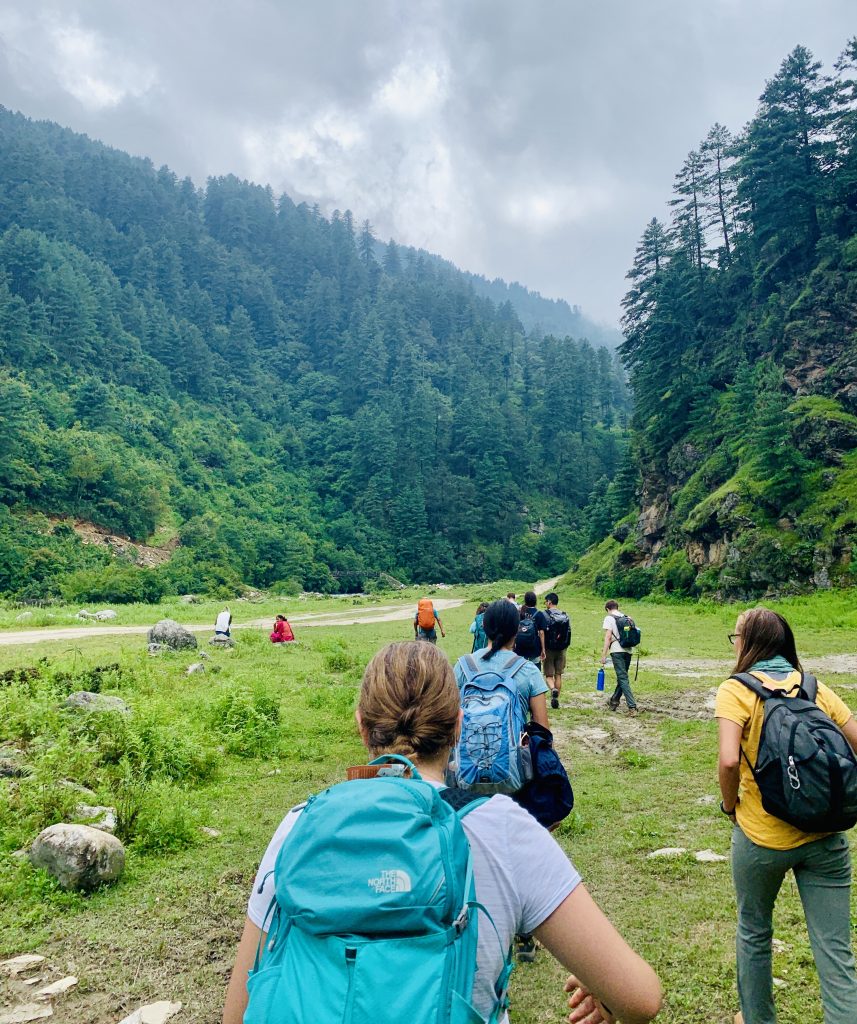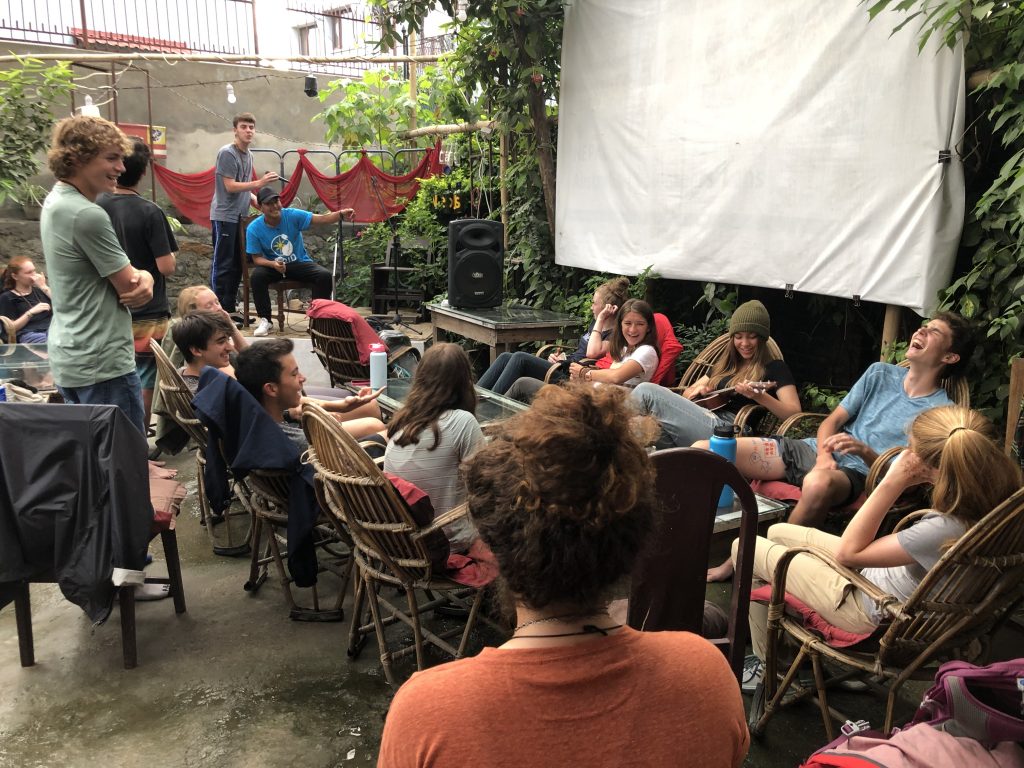Nepal
Village Immersion, Monasteries, & Trekking in the Everest Valley
Immerse yourself in a remote village at the base of Nepal’s Everest Valley and collaborate with locals on meaningful projects. During your student travel program in Nepal, help with construction of a community building and teach English to Sherpa youth and young Buddhist monks. Rest and reflect in a monastery, collect stories of the Dalai Lama from Tibetan refugees, and trek through Himalayan villages on this high school summer service program.
- Highlights
• Trek between villages in the picturesque Everest Valley
• Learn to meditate on a retreat with young Buddhist monks
• Follow the monkey calls to the temple of Swayambhunath
Itinerary
This itinerary represents our best projection of the group’s schedule. However, we may implement changes designed to improve the quality of the program.
Meet your fellow high school student travelers and one of your leaders in New York, and fly together to Kathmandu, Nepal. To learn more about how we organize travel, click here.
Arrive in Kathmandu and spend the first days of your program near Pashupatinath, one of the most sacred Hindu sites in Nepal, and Boudhanath Stupa, one of the largest and most ancient Buddhist monuments in the world. Join pilgrims from near and far in their morning walking and tea rituals, visit a hilltop temple teeming with monkeys, and participate in your group orientation. Then, in preparation for our service component, collaborate with an organization supporting vulnerable youth through education programs, healthcare services, vocational training, and job placement.
Immerse yourself in the life of a village in the Solukhumbu region, at the base of the valley leading up to Mount Everest. Stay in the guest quarters of a nonprofit resource center and educational program for Sherpa youth who are completing their high school studies. Help with community-initiated construction and improvement projects at their school and in the village, paint classrooms, join in English conversation exercises, or lead after-school enrichment activities. During the afternoons, interview Tibetan monks in a mountainside temple, join neighboring households for tea, play volleyball (Nepal’s national sport) with new friends, and explore the local market. In the evenings, exchange stories about cultural heritage, learn traditional dances, and help cook local specialties such as momos.
At the midpoint of your service work, hike from your village on the trail that leads up to Mount Everest with professional Sherpa guides. Follow in the footsteps of Tenzing Norgay Sherpa and Sir Edmund Hillary, who first summited Everest in 1953. Explore blooming rhododendron forests, and stop to chat with the families of Sherpas to hear epic stories of their mountaineering feats and Himalayan lore. Spend one full day at the Taksindu Tharling Sheddrup Monastery getting to know the monks and learning about Tibetan Buddhism. Join the novice monks in their classes, practice meditation, and experience a Tibetan puja ceremony with the presiding lama. Stay in family-run guesthouses and wake up to stunning views of the snowcapped Himalaya.
Return to your host village to complete your service projects, work on your independent project, and celebrate your new friendships with local families.
Travel from Solukhumbu to the medieval city of Bhaktapur which lies within the Kathmandu Valley. Here, ancient architecture offers a glimpse into Nepalese life before the arrival of modern influences. Stroll ornate palaces and the centuries-old Durbar Square, and step into mystical temples that welcome pilgrims from around the world. Meet with master artisans to hear how their cultural heritage is being preserved in the present day and try your hand at traditional pottery making.
Return to Kathmandu proper to explore the shrines of the old city, peruse craft markets, then enjoy a farewell meal with our Nepalese hosts and friends before flying home.
Fly with your group and a leader from Kathmandu to New York, then continue on to your final destination. To learn more about how we organize travel, click here.
Itinerary
This itinerary represents our best projection of the group’s schedule. However, we may implement changes designed to improve the quality of the program.
Meet your fellow high school student travelers and one of your leaders in New York, and fly together to Kathmandu, Nepal. To learn more about how we organize travel, click here.
Arrive in Kathmandu and spend the first days of your program near Pashupatinath, one of the most sacred Hindu sites in Nepal, and Boudhanath Stupa, one of the largest and most ancient Buddhist monuments in the world. Join pilgrims from near and far in their morning walking and tea rituals, visit a hilltop temple teeming with monkeys, and participate in your group orientation. Then, in preparation for our service component, collaborate with an organization supporting vulnerable youth through education programs, healthcare services, vocational training, and job placement.
Immerse yourself in the life of a village in the Solukhumbu region, at the base of the valley leading up to Mount Everest. Stay in the guest quarters of a nonprofit resource center and educational program for Sherpa youth who are completing their high school studies. Help with community-initiated construction and improvement projects at their school and in the village, paint classrooms, join in English conversation exercises, or lead after-school enrichment activities. During the afternoons, interview Tibetan monks in a mountainside temple, join neighboring households for tea, play volleyball (Nepal’s national sport) with new friends, and explore the local market. In the evenings, exchange stories about cultural heritage, learn traditional dances, and help cook local specialties such as momos.
At the midpoint of your service work, hike from your village on the trail that leads up to Mount Everest with professional Sherpa guides. Follow in the footsteps of Tenzing Norgay Sherpa and Sir Edmund Hillary, who first summited Everest in 1953. Explore blooming rhododendron forests, and stop to chat with the families of Sherpas to hear epic stories of their mountaineering feats and Himalayan lore. Spend one full day at the Taksindu Tharling Sheddrup Monastery getting to know the monks and learning about Tibetan Buddhism. Join the novice monks in their classes, practice meditation, and experience a Tibetan puja ceremony with the presiding lama. Stay in family-run guesthouses and wake up to stunning views of the snowcapped Himalaya.
Return to your host village to complete your service projects, work on your independent project, and celebrate your new friendships with local families.
Travel from Solukhumbu to the medieval city of Bhaktapur which lies within the Kathmandu Valley. Here, ancient architecture offers a glimpse into Nepalese life before the arrival of modern influences. Stroll ornate palaces and the centuries-old Durbar Square, and step into mystical temples that welcome pilgrims from around the world. Meet with master artisans to hear how their cultural heritage is being preserved in the present day and try your hand at traditional pottery making.
Return to Kathmandu proper to explore the shrines of the old city, peruse craft markets, then enjoy a farewell meal with our Nepalese hosts and friends before flying home.
Fly with your group and a leader from Kathmandu to New York, then continue on to your final destination. To learn more about how we organize travel, click here.
Sandwiched between the jungly plains of the Indian subcontinent and the sky-scraping Himalaya mountain range on the northern border with Sino-Tibet, Nepal spans topographical extremes. It is also home to over 100 distinct ethnic groups with diverse traditions, and is the spiritual center for Hindus, Buddhists, mystics, and mountaineers from around the world. The vast majority of Nepalis practice Hinduism, though Tibetan immigrants and refugees in the north largely identify as Buddhist and the religious practices and celebrations mingle. Nepal’s natural wonders are also sacred to people worldwide: the northern border is crowned with eight of the world’s ten tallest mountains, including Mount Everest, the highest peak on earth.
Nepali is the official national language and the lingua franca spoken across the country’s many ethnic groups. Most Nepali people also speak their ethnic dialect, and many youth and professionals learn English to engage with a globalizing economy.
Summer is the monsoon season across southeast Asia, bringing nourishing rains to a humid, lush, and blooming landscape. Our host village is situated on a mountainside at the base of the Everest Valley. Temperatures range from the 55–80°F (13–27°C) during the day with cooling in the evenings and overnight. Our days may be punctuated by showers.
The typical Nepalese meal is vegetarian dal-bhat-tarkari: a spiced lentil soup (dal) served over rice (bhat) with curried vegetables (tarkari) and a variety of chutneys. Momos — steamed buns with fillings — are a popular delicacy.
Sandwiched between the jungly plains of the Indian subcontinent and the sky-scraping Himalaya mountain range on the northern border with Sino-Tibet, Nepal spans topographical extremes. It is also home to over 100 distinct ethnic groups with diverse traditions, and is the spiritual center for Hindus, Buddhists, mystics, and mountaineers from around the world. The vast majority of Nepalis practice Hinduism, though Tibetan immigrants and refugees in the north largely identify as Buddhist and the religious practices and celebrations mingle. Nepal’s natural wonders are also sacred to people worldwide: the northern border is crowned with eight of the world’s ten tallest mountains, including Mount Everest, the highest peak on earth.
Nepali is the official national language and the lingua franca spoken across the country’s many ethnic groups. Most Nepali people also speak their ethnic dialect, and many youth and professionals learn English to engage with a globalizing economy.
Summer is the monsoon season across southeast Asia, bringing nourishing rains to a humid, lush, and blooming landscape. Our host village is situated on a mountainside at the base of the Everest Valley. Temperatures range from the 55–80°F (13–27°C) during the day with cooling in the evenings and overnight. Our days may be punctuated by showers.
The typical Nepalese meal is vegetarian dal-bhat-tarkari: a spiced lentil soup (dal) served over rice (bhat) with curried vegetables (tarkari) and a variety of chutneys. Momos — steamed buns with fillings — are a popular delicacy.
What to Expect
Review specific program expectations here. For more general information:
During your time in Nepal, you can expect to work on several different volunteer projects—light construction projects where you may learn to mix cement and lay blocks or paint a community building, environmental projects such as planting seedlings, and educational projects such as holding English conversation classes with local youth. The focus of this program is learning about another culture by forming meaningful relationships with local people and undertaking a shared service experience together. You should come to the summer with an open-mind, eager to participate in new experiences and interested in exploring another culture and way of life. Everyone participates in all of the group’s projects on a rotating basis, and lends a hand in meal preparation and cleanup. To learn more about our Service programs click here.
Pursue an independent project and explore an aspect of local culture of particular interest to you—learn to make momos with a family in the host community, collect stories from Sherpa elders about mountain climbing in the high Himalaya, learn a traditional song or dance, explore the role of yoga or meditation in daily life, or conduct a series of interviews with local people to learn more about their lives.
To encourage full engagement and immersion in the Putney travel experience, we limit the use of cell phones and other devices on our High School programs. Students are allowed to use their phones in transit to the program, and keep their devices throughout. During in-country orientation, leaders will lock phones with a code, unlocking them for the second half of the program. During the tech-free portion of the program, students have the opportunity for a weekly call home according to a pre-arranged schedule. For more details, please see our FAQ.
This is a physically active summer travel program. You can expect to hike, work on projects, farm, and play volleyball. You do not need to be at peak fitness to participate, but it is important that you have a desire to be physically active, and that you are excited about trying all activities.
This program visits high-altitude destinations—our Solukhumbu host village is at 7,500 feet/2,286 meters, and on our trek we climb up to about 9,500 feet/2,896 meters.
In Kathmandu and Bhaktapur, we stay in simple guesthouses in double and triple rooms. In our host village, our group stays in the guest residence of a nonprofit educational center. On the trek, we stay in teahouses and small mountain lodges. Leaders reside with students throughout the program.
In our host village, we eat vegetarian meals prepared by Nepali cooks, and students help cook both traditional and Western-style dishes. In Kathmandu and Bhaktapur, we eat in restaurants with the chance to order your choice of food. On our trek, we eat simple, hearty meals at mountain guesthouses.
What to Expect
Review specific program expectations here. For more general information:
During your time in Nepal, you can expect to work on several different volunteer projects—light construction projects where you may learn to mix cement and lay blocks or paint a community building, environmental projects such as planting seedlings, and educational projects such as holding English conversation classes with local youth. The focus of this program is learning about another culture by forming meaningful relationships with local people and undertaking a shared service experience together. You should come to the summer with an open-mind, eager to participate in new experiences and interested in exploring another culture and way of life. Everyone participates in all of the group’s projects on a rotating basis, and lends a hand in meal preparation and cleanup. To learn more about our Service programs click here.
Pursue an independent project and explore an aspect of local culture of particular interest to you—learn to make momos with a family in the host community, collect stories from Sherpa elders about mountain climbing in the high Himalaya, learn a traditional song or dance, explore the role of yoga or meditation in daily life, or conduct a series of interviews with local people to learn more about their lives.
To encourage full engagement and immersion in the Putney travel experience, we limit the use of cell phones and other devices on our High School programs. Students are allowed to use their phones in transit to the program, and keep their devices throughout. During in-country orientation, leaders will lock phones with a code, unlocking them for the second half of the program. During the tech-free portion of the program, students have the opportunity for a weekly call home according to a pre-arranged schedule. For more details, please see our FAQ.
This is a physically active summer travel program. You can expect to hike, work on projects, farm, and play volleyball. You do not need to be at peak fitness to participate, but it is important that you have a desire to be physically active, and that you are excited about trying all activities.
This program visits high-altitude destinations—our Solukhumbu host village is at 7,500 feet/2,286 meters, and on our trek we climb up to about 9,500 feet/2,896 meters.
In Kathmandu and Bhaktapur, we stay in simple guesthouses in double and triple rooms. In our host village, our group stays in the guest residence of a nonprofit educational center. On the trek, we stay in teahouses and small mountain lodges. Leaders reside with students throughout the program.
In our host village, we eat vegetarian meals prepared by Nepali cooks, and students help cook both traditional and Western-style dishes. In Kathmandu and Bhaktapur, we eat in restaurants with the chance to order your choice of food. On our trek, we eat simple, hearty meals at mountain guesthouses.
A Day in the Life: Host Village
- Morning
- Afternoon
- Evening
A Day in the Life:
Host Village
- Morning
- Afternoon
- Evening
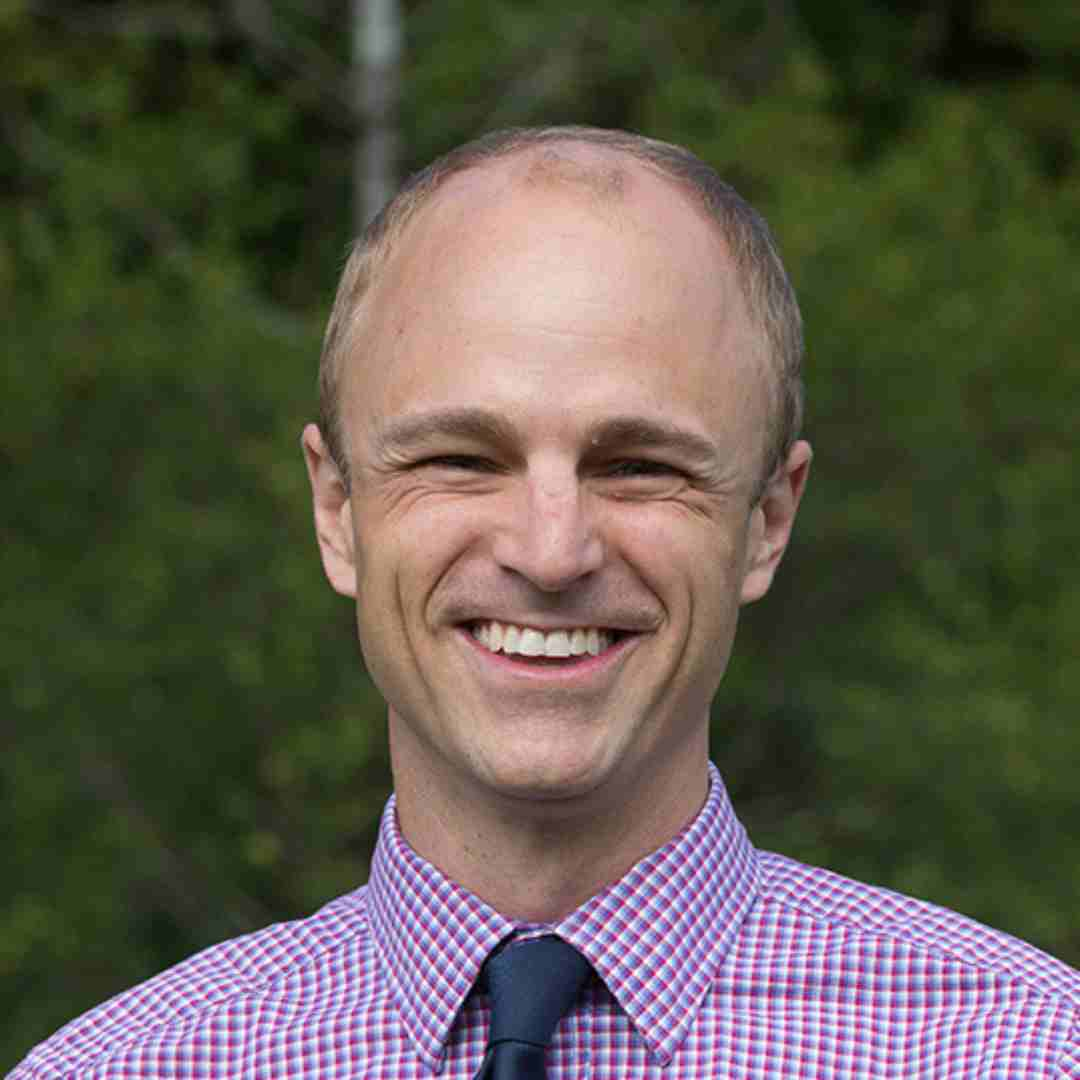
Program Directed by
If you have questions or would like to talk further about this program, please get in touch!




